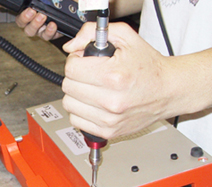
Torque measurement is paramount for many manufacturers. Simply running a fastener or bolt down until it’s snug and tight and assuming the torque control process is complete, is no longer sufficient. Measuring torque doesn’t stop once the assembly process is complete. As part of the overall quality control process, manufacturers should include a “Torque Auditing” program. A method to detect loose fasteners or any signs of joint relaxation. Torque auditing validates the fastening process, the torque tool, the product design and the materials used for the application.
The precise control of torque is a key to quality assembly and can ensure that products perform as expected. A single fastener, inaccurately or incorrectly tightened, can lead to the failure of a product, which impacts the bottom line. In many cases, companies spend a great deal of time and money for disposal or repair of damaged parts during assembly, the result of improper torquing.
Key reasons for conducting a torque audit:
- Substantiates assembly procedures reflect actual practice (what we say is what we do)
- Reveals the consistency with the assembly process (from person to person, or day to day)
- Uncovers inaccuracies with the assembly process so it can be quickly corrected
- Promotes ongoing corrective actions
- Process improvement
A torque sensor is a finely tuned instrument designed for testing and monitoring torque applications. Designed for torque evaluation and verification, a torque sensor is a laboratory grade instrument that is commonly used for quality control, R&D and calibration applications. A torque sensor is used in conjunction with a torque analyzer. For low torque auditing applications, a torque screwdriver sensor is an option. For higher torque needs, a torque wrench sensor is the instrument of choice.
A digital torque wrench can also be used to accurately audit the residual torque on a previously tightened threaded fastener. Ensure the wrench has memory to store the audit data and the ability export the data to a computer.
The screwdriver sensor, wrench sensor or digital torque wrench can used to perform three common torque auditing methods.
1) First Movement Test – Once the fastener has been tightened, employ the use of torque measuring tool. Mark the tightened fastener and surrounding application. In the tightening direction, begin to slowly apply force to the tool until the first movement in the fastener is noted. The reading recorded is a good indication of the original torque applied to the joint. This is the best way to determine residual torque.
2) Loosening Test – This is a similar process to the first movement test described above, except instead of the tightening the fastener, the torque is applied in the direction that loosens the fastener. At the point the fastener breaks loose, the torque reading is recorded. The torque value to loosen the fastener is the approximate torque that was applied to the joint.
3) Marking Test – Once the fastener tightened, mark clearly the surface of the fastener, nut or bolt and continuing the mark onto the surface being clamped for reference. This time loosen the fastener and retighten until the marks on both application and fastener are aligned. The torque required to return the fastener to its original location is the reference to the original torque applied to the fastener.
Using a quality torque sensor or digital torque wrench makes a safer world through accuracy and precision. Measuring torque is essential for companies to ensure their product’s quality, safety and reliability isn’t compromised. The failure of a three-cent fastener that isn’t properly tightened can lead to catastrophic or latent failures. Fasteners that are insufficiently fastened can vibrate loose and excessive torque can strip threaded fasteners.
With 50 years of experience, Mountz is a pioneer in developing torque testers and sensors. Need assistance with any torque testing application, contact us we’re happy to assist.